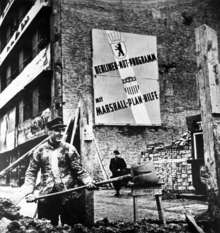The Cold War/The Marshall Plan and the Reconstruction of Europe

Europe, after being hit by the biggest war in history, was devastated. Its economies were bankrupt, food supplies were at an all-time low and there was a severe lack of industrial output, due to the destruction of factories by heavy bombing during the war. The Communist parties in Western Europe were gaining popularity and it seemed likely that the people would elect them if living conditions didn't improve soon.
This situation alarmed the Americans, who were desperate to guard their sphere of influence against the increasing threat of communism. In June 1947, the U.S. Secretary of State, George C. Marshall (a war veteran) announced at Harvard University, Massachusetts, that the USA would provide economic aid and equipment to help the economies of Europe recover and rebuild themselves. This came to be known as the "Marshall Plan". The Marshall plan was implemented by President Harry S. Truman.
The offer was open to the USSR and other Eastern European nations, but Stalin rejected it, saying that that the aid was politically motivated. He thought that the Marshall Plan was an attempt by the USA to win the hearts and minds of the people in the Soviet sphere of influence so that they would support the capitalist West.


The Cold War
Introduction - Background - Strategy - Truman Doctrine - Marshall Plan - Berlin Blockade - Korean War - Hungarian Uprising - Cuban Missile Crisis - USSR under Gorbachev - USA under Reagan - Arms Race - Space Race
Cover - Contents - Study Guide
Please read the page creation guidelines before creating a new page.